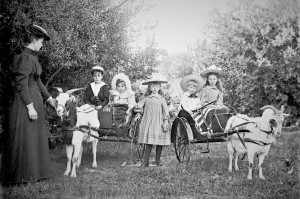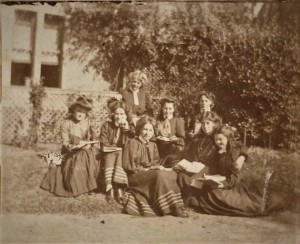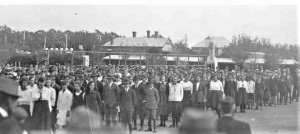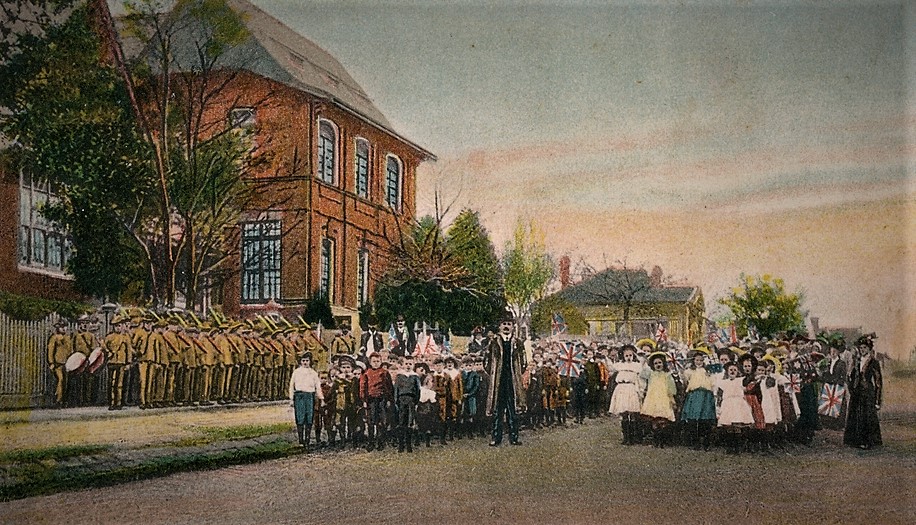For most of Australia’s European settlement history opportunities for parents and others to choose schools for the children in their families and care were absent or highly constrained. The major effort over the long term was to provide schools for increasing proportions of the population, and by the end of the nineteenth century, to compel families with limited interest in schooling children, to force their attendance.
It was only in the late twentieth century that public policy reoriented significantly in the direction of providing opportunities for parents to choose schools in a market of schools. Although this entry refers mainly to parents and families making decisions about schooling, it should be noted that through to the gold rush period (1850s) and beyond, families were often unstable. Persons other than parents have often been involved in making decisions about where children and youth should be schooled.
The motivations and capacities of parents and others to choose schools for their children are conditioned by a large number of factors. The least of these for most of the two centuries was an assumption that parents acted as detached, market-aware and ‘rational’ choosers. Where choice was possible before the mid-twentieth century, the decision to send a child to a certain school or class of school was embedded in the social aspirations, loyalties and developed associations of families.
This entry is closely related to two other entries in this dictionary, Public and private in Australian schooling and Differentiated schooling. The most substantial history of school choice and school markets in Australia occurs in Campbell, Proctor and Sherington (2009), School Choice, pp. 36-57. It surveys the period of convict settlement in the late eighteenth century through to the early twenty-first century.

“They’ll have to go to school. How much of a choice do I have?” Photo, Alexander Dummer.
Reasons to choose a school
In listing the common reasons justifying the choice of school and enabling the operation of school markets, four conditioning axioms need to be stated.
• It is rare for these phenomena to act in isolation. They form a matrix of more or less embedded behaviours and beliefs that act on one another.
• United family, class or community strategies are not always in evidence. Decisions concerning choice of school are often fractious. Children, parents, grandparents and others may all have different stakes in the decision and have varying power in determining the outcome.
• The strength of different elements in the following list of phenomena to affect decision-making varies over time. For example, religion as producing loyalty to certain schools has tended to decline over time, while the power of the results in public examinations and other measures of school success appears to have increased.
• The fourth is to reiterate that school choice and the possibility of accessing a schools market is restricted by any number of factors, but two of particular significance are the existence of a range of schools in an area, or the presence of exclusionary tests and conditions that disallow enrolments, and therefore choice, in some schools.
Phenomena that affect the schools that parents and others choose for young people
The following list is not exhaustive, but it is based on the interview-based research reported by Campbell, Proctor & Sherington (2009). Often apparently mundane conditions, for example the school’s distance from home or the presence of siblings in a school, can be the most influential. Such factors often contradict the idea of parents and other choosers as unconstrained or ‘rational’ choosers of the ‘best school’ in an open market.
The following list of possible influences rarely operate in isolation. In some cases, a listed factor is an elaboration of another. In most cases a combination is responsible for a choice in a market of schools. Some factors may appear peculiar, for example the ‘pursuit of respectability’. If the winning of respectability is not important to many in the twenty-first century, it assuredly was in the nineteenth and much of the early twentieth.
Broad social factors that may affect school choice:
• Religious affiliation and church membership, or their absence.
• Social class position, mobility and aspiration.
• Ethnic, cultural and community origins and affiliation.
• Sex of children or other gendered or sexual orientation characteristics.
Family, community and class factors
• Long-term loyalty to particular schools or school types.
• Use of schools in the pursuit of upward social mobility.
• Schools as socialising agents in the development of children.
• Pursuit of respectability and improved social status.
• Desire that siblings and other family members attend the same or a different school.
• Wealth of the family.
School or class of school enrolment conditions and policies as factors
• Exclusive or inclusive school enrolment policies.
• Affordability of school fees.
• Availability of scholarships or other support.
Perceptions of individual schools or school types
• Schools as aligned with family ‘values’.
• Discomfort with certain groups, often marked by social class or ethno-cultural backgrounds, perceived as dominating certain schools.
• Desire to lodge children in schools that appear to contain substantial proportions of acceptable or admired social groups.
• Perceptions surrounding teacher quality.
• Reputation for academic or other measures of success.
• Reputation for disciplined and orderly classroom and school culture.
• Reputation for being a well-managed school.
• Reputation for a commitment to student welfare.
Locality factors
• Friends attending a certain school.
• School as a community school.
• Distance of school from home.
• Availability of public and other transport to school.
• A relationship existing between a prior school and the next school.
Special needs provision and other factors, including curriculum
• Teaching of literacy and numeracy.
• Individual children requiring special education, from disability provision to gifted and talented provision. (Intelligence testing played a crucial role in the twentieth century. It could determine which school a child attended contrary to parental choice.)
• Particular specialisations of schools, including sport, arts, music, technology, commercial subjects and languages.
• Other specialisations of an academic kind, including classical and modern languages, mathematics, sciences and histories.
• Relevance of a curriculum for vocational intentions.
• Facilities and resources of a school.
• Curriculum and extra-curriculum (including sports, the arts and clubs) of a school.
Credentials, training and provision of gateways to further education, training and employment
• The ability of a school to teach a curriculum leading to credentials valued in a market.
• The perception that certain schools advantage students in meeting particular further education, apprenticeship, employment or future training goals.
In outlining these factors, there is rarely a simple divide between their relevance for government or nongovernment schools. For example, long-established and wealthier middle class families may have been more likely to choose certain nongovernment schools, especially in Victoria, but the selective government schools in New South Wales, have also secured substantial loyalty from within this class.
Schools belonging to different sectors often vary widely in their attractiveness to different population groups. In the early twenty-first century many academically selective public schools in New South Wales rivalled elite nongovernment schools for their social exclusivity. A large proportion of young people attending them came from university-educated parents employed in well-paid and secure professions. In the nineteenth century other apparent contradictions occurred, such as girls from Protestant families being enrolled in Catholic collegiate schools run by religious sisters, presumably for the ability of such schools to protect such girls and encourage certain kinds of femininity. Sometimes the Catholic girls’ schools offered an accomplishments curriculum (music, literature, languages, embroidery, etc.) that was unavailable elsewhere. In the twentieth century a large proportion of Catholic students attended government schools, especially in the period when most Catholic schools lacked the range of resources that government schools clearly had, despite the directives of the church pointing to the ‘godlessness’ of government schools.
Before the twentieth century
European settlers, mainly of British and Irish origin, in the early Australian colonies brought with them ideas about the different kinds of schools that should be available, especially as family wealth increased to the point that school fees could be afforded. Schooling was not routinely provided free of charge by colonial governments until the 1870s and in some cases later. Schooling associated with the incarceration of orphans and other child populations considered unruly, including children from Aboriginal and Torres Strait Islander communities, was ‘free’ in terms of fees, whether provided by governments or the missions of the different religious denominations. The idea that these schools existed for parents to choose within a market does not describe their operation.
The range of schools that developed from the late eighteenth century could include the government-funded schools such as those for orphans, and assisted schools, mainly run by the Church of England or its colonial chaplains. (For example, schools run by the Church and Schools Corporation.) From the 1840s, National and other government assisted and funded schools were developed, subject to different regulations in the various colonies. In South Australia for example, from 1851 no government funding could be used to support church (denominational) schools. In Western Australia, Queensland, New South Wales and Victoria, government funding of both National or equivalent schools, and denominational schools was usually supervised by boards of education through to the 1870s.

An elementary denominational school for children from families affiliated with the Church of England. Dunolly near Bendigo, Victoria, c. 1861. State Library of Victoria, b36129
Under these circumstances, where the population allowed and where National and denominational schools existed, choice of school was possible. Indeed, there is good evidence that in the 1840s to 1870s the different churches, especially Anglican, Catholic, Wesleyan (Methodist), Presbyterian (and in South Australia and Victoria, Lutheran) actively sought to build schools so that members of their denominations could send their children to schools taught by persons of their own faith.
The developments were not necessarily about creating a school market; and certainly not a ‘free’ market that imagined autonomous rational ‘consumer’ parents examining the merits of the different schools within a district. The expectation of the churches was that families of a particular faith would send their children to a school of that faith. Religious instruction and moralisation within the faith were expected outcomes. The expectations of the different churches were not always met of course. From the mid-nineteenth century the Catholic church was concerned that too many Catholic children attended National and then government schools, seen as too secular and covertly Protestant. These National and government schools, perhaps with the exception of Victoria, usually held to the view that their approach and curricula, rather than being completely secular or ‘godless’, were responsive to ‘common Christianity’ [see Glossary below]. Sometimes very limited denominational religious instruction was also provided for in these new government or public schools.
In the very limited market of schools that grew up in the pre-1870s era, government assistance and fees charged were often insufficient to produce satisfactory schools, especially those run by churches. The argument was increasingly accepted by the legislative councils and parliaments of the colonies through the mid-nineteenth century that the provision of one efficient government school which met superior educational goals was much more valuable than assisting many poor and inferior schools, denominational or not, in the same district.
This description of the pre-twentieth century school market is incomplete without acknowledging the strength of the genuinely private schools. Private schools were usually owned by individuals and families. Many of their principals were women. Private schools existed at all levels in the schooling market, or perhaps ‘schooling terrain’ is the better phrase. For the very poor there could be dame schools [see Glossary below]. Protestant ministers of religion could supplement their parlous incomes by establishing schools. Private schools were variably named. The word academy as well as grammar school or college was often used. Some private schools became leading schools in their colonies, some with boarding houses, patronised by the respectable and wealthy classes. Post-elementary private schools were invariably single-sex.
From the 1870s, whatever had existed of a school market declined with the rise of government or public school systems that sought to provide schoolhouses with trained teachers across the countryside; wherever there were sufficient children who could be compelled to attend. For the Catholic parochial elementary schools, the survival of old and new school foundations was dependent on the unpaid labour and charity of religious orders such as Mary McKillop’s Sisters of St Joseph.

The wealthiest family in South Australia educated its children. At least one boy went to St Peters College, the most prestigious Anglican college. The girls had governesses at home. The children and their billy goat carts, c.1900. State Library of South Australia, PRG-733-453.
The post-1870s period is also the time when larger nongovernment collegiate (corporate) schools, often concentrating on secondary subjects that might lead to university matriculation, began a rapid expansion. There were also the beginnings of new government high schools (from 1879 in South Australia and 1885 in New South Wales. The new ‘corporate’ and/or ‘systemic’ schools [see Glossary], government and nongovernment, rapidly drove the genuinely private schools towards collapse. In some cases, private schools were taken over by churches. As far as a market existed in the late nineteenth century, its character had changed. Increasingly government schools, with a group of poorer Catholic schools dominated the primary levels, and small private schools drew closer to disappearing. In the secondary sector, larger collegiate schools, usually owned by churches tended to dominate, but were about to be challenged by new state Education Department-run high schools.
At the end of the nineteenth century a market of schools barely existed at the primary and elementary level. If a family was not Catholic, there was little choice beyond the government school. At the secondary level, the oldest sector of genuine private schools was in decline. Did the state high schools and church colleges constitute a market? In some respects, yes, but in others, no. Without the ability to pay fees or win rare scholarships, the collegiate schools were inaccessible to great numbers of young people. Nor was it particularly easy to access the state high schools. Fees were usually charged, and the passing of entrance tests was required. Examination success was the essential condition allowing youth to remain in a state high school. If families had children who could not pass the exams, or could not afford fees, there was little opportunity for any kind of secondary education, let alone choice of school.
At the end of the nineteenth century secondary education was mainly regarded as middle class education. Working class families usually had little time for an academic education in the modern subjects [see Glossary], mathematics or the classical languages (Greek and Latin). Large numbers of working class youth, and often the older children of poorer rural farmers, were expected to work, to contribute to household economies, often from childhood and certainly during adolescence, rather than going to a post-elementary school.
School markets were restricted, but subject to change over the 1788-1901 period. Possibilities for genuine school choice were limited. For the squattocracy then graziers and the wealthier business and professional middle class, the power to choose schools, or hire governesses or tutors into the family, disregarding schools altogether, existed. For a few families the option to send youth to schools in England was also available.
The twentieth century through to the 1970s

Girls and staff in an exclusive non-denominational corporate school, Ascham, in Sydney, 1919. State Library of New South Wales, P8441/8.
In this period, especially following the Great War (1914-1918), little changed in terms of school markets or school choice at the primary or elementary level. Some of the church colleges developed preparatory schools for pre-secondary children. There was limited development of new alternative schools such as those organised by the Theosophical Society and later the Anthroposophical Society (Steiner schools). Some newer private schools adopted the Dalton plan to organise their curriculum, but the overwhelming majority of children were in government schools. Usually these were zoned, meaning that one government school only was available for enrolment even if another was close by. The Catholic and Lutheran primary schools survived, although the latter were closed in South Australia during the Great War.
Any market of schools and the possibility of school choice was extremely limited at the primary level. From the period of the Great War (1914-1918) however, there was a great expansion in government secondary education, and further expansion for the church colleges.
The provision of secondary schooling improved dramatically, but some of the new schools, government central and technical, ran restricted or specialist curricula. During adolescence youth were to be increasingly supervised by adults in some kind of secondary school. Nevertheless, with the school leaving age at the end of the thirteenth, then fourteenth year, prolonged secondary schooling remained an experience for the minority. Early in the century, such schools could only be chosen if academic merit was proven. The technical and central schools offered post-primary courses of study that terminated after two to four years.

The new government secondary schools competed with the nongovernment collegiates. Students at Unley High, South Australia, 1920.
In terms of markets, the real question was whether the state secondary schools, high, technical, central, area, and more, would dominate. With the arrival of comprehensive high schools from the 1960s and their popularity in the new suburbs of the expanding Australian cities, it seemed for a time that the church collegiate schools faced a gloomy future. In the attempt to sustain enrolments, some became coeducational rather than single-sex. Without government assistance, the fees families paid to attend such schools were substantial. A possibility of new government assistance for non-government schools was glimpsed in the 1960s with two federal government programs, one to assist schools in the development of science laboratories, the other, libraries.
The beginnings of a substantial school market with expanded possibilities for parental choice began in the 1970s. From 1974 the Australian Schools Commission was asked to supervise the distribution of federal government funding to nearly all Australian schools, government and nongovernment, with priority given to schools and systems that could be judged disadvantaged. By the late 1970s the emphasis on needs-based funding shifted to encouraging a market of schools, and the enabling of parental choice of schools within such a market.
From the 1980s to the early twenty-first century
In this period, not only have existing schools in the nongovernment sector been supported with government assistance, but new schools and school systems have flourished. Mid-nineteenth century participants in school provision at the primary level have returned, with the Anglicans, Uniting Church, Lutherans and others building new schools. These, along with new secondary colleges are sufficiently supported by state aid to charge low- to middle-range fees, enabling a greater proportion of Australian families to participate in a growing school market.
The broad social policy context for this change in education was the rise of neoliberalism, or economic rationalism as it tended to be named in Australia. Big government, it was argued, was inefficient and wasteful; smaller government, encouraging the production of markets of private and corporate providers, was expected to bring dividends in the more efficient management of services and resources. Smaller government would improve a country’s citizens by making them less reliant on the ‘nanny’, welfare state. It was easy to imagine schools, government, but especially nongovernment, operating under these new circumstances, though the agreed continuing need for compulsory attendance, and making sure that schooling was available in areas where markets could not operate, were hindrances.
Along with the older churches, newer groups of so-called ‘Christian’, and other school providers, are supported with government funding. As a result of policy associated with multiculturalism and social diversity another group of schools based on ethno-religious-national communities has been founded. These included schools of various Jewish sects, Maronite Catholic, Greek Orthodox, Muslim and many more. The Catholic church has been astute in their use of government funding to consolidate their share of the school market. The growth in religious (or faith) schools is remarkable considering the decline in religious faith amongst the Australian population over the period. It suggests that faith schools are often chosen by families for reasons other than religious.
The following tables show that the outstanding growth in schools and enrolments has occurred in the nongovernment, non-Catholic sector from the mid-1970s through to 2017.
 These tables do not take into account the rise in home schooling, that is an increase in the number of families exercising their right to choose no school. Nor do they reflect school consolidation policies in all systems and sectors. By not distinguishing between primary and secondary schools, the tables under-represent the more rapid expansion of the nongovernment sector at the secondary level.
These tables do not take into account the rise in home schooling, that is an increase in the number of families exercising their right to choose no school. Nor do they reflect school consolidation policies in all systems and sectors. By not distinguishing between primary and secondary schools, the tables under-represent the more rapid expansion of the nongovernment sector at the secondary level.
This period from the 1980s has seen the emergence of a genuine market of schools in well-populated country districts and large parts of all Australian cities. In the more rural and remote areas a range of schools for parents to choose from remains rare.

Marketing message from a nongovernment collegiate girls school in Sydney. Such messages are usually accompanied by photographs of good-looking, immaculately groomed, uniformed students. Competing in a school market requires highly developed marketing skills.
For schools and school systems struggling for enrolments in marketised circumstances, considerable resources are devoted to advertising and managing promotional activities. Adverse publicity is feared by all schools. In the nineteenth century any kind of scandal in a private school could quickly lead to school closure. In more recent times publicity for example from the Royal Commission into Institutional Responses to Child Sexual Abuse (report published, 2017) has caused problems for many schools, especially those with boarding houses in the nongovernment sector. Such schools retain however, the advantages they had in the nineteenth century over the older private schools. They have stable organisations and the resources to survive negative publicity.
The development of a school market hardly follows classic market theory. For some, the school market is better described as a quasi-market, because it is very substantially dependent on governments creating the conditions for its existence. Federal governments in the early twenty-first century invest far more revenue in the nongovernment schooling sector than the government. Federal government policy provides incentives for many more parents than historically able, to choose schools other than those in the government sector. At the same time, many of the older zoning restrictions on enrolment in a government school have been removed, so choice exists between government schools as well as between government and nongovernment. Government schools are often at liberty to develop curriculum specialities that allow competition for enrolments. One of many consequences of such developments is that children and youth travel further to attend a school than they did in the twentieth century.
Conclusion
With few restrictions on the enrolment policies and fees charged by nongovernment schools across Australia’s post-1788 history, those schools have remained free to choose students and families, as well as parents and families to choose them. The schools that have traditionally educated the children and youth of the wealthier, more powerful families in Australia can continue to specialise in such enrolments by charging very high fees and controlling their enrolment and expulsion policies. The elevation of choice as a priority in Australian school funding policies does not necessarily lead to more available or egalitarian schooling.

The kind of school that most children attended. There was no real choice until late in the twentieth century. Surrey Hills State School, children and teachers, Victoria, 1911. State Library of Victoria, H2008.12/112
For families in poverty, the possibility of active school choice has been unlikely for most of Australia’s history since European settlement. The marketisation of schools often leads to residualised schooling where families are confined to schools where educational achievement and ‘success’, is low. Richard Teese (2000) has argued that school choice for wealthier communities leads to the creation of schools that are forced to specialise in the children of less well-off families. In Australia, the prioritisation of school choice and school markets in educational policy has likely led to the further rigidification of school and social hierarchies, a consequence of which has been, according to the first Gonski review into Australian education (2011), slippages on international measures of educational achievement.
Despite this, there have always been sectors of the population reluctant to give up whatever advantage can be secured from their ability to choose schools. Any attempt to wind back such privileges immediately activates well-organised parent and school lobbies.
The history of school markets in Australia is a history of relative fragility unless substantial government funding is invested to develop and maintain them. A consequence in the present period has been a dramatic change in the ways parents, children and youth are imagined as using and choosing schools. In the nineteenth century most were expected to be satisfied with the mere provision of a school. Parents had a right to enrol their children in an elementary school. (Not all parents though; in some colonies and states Aboriginal enrolments could be rejected.) From the late twentieth century, parents expected far more than provision, they began to assume a new right, the right to a choice of schools. In many cases the choice of school in the early twenty-first century required that parents act as consumers, engaging similar skills as they used in the search for other services and goods in a market. There are clear winners and losers under these circumstances. Not all parents imagine themselves as consumers. Many are either disconnected from or frustrated by the whole process. That said, school markets have arrived and where the responsibility of governments from the late nineteenth century to the mid-twentieth was primarily to provide a school in a district, since that time it appears to have become the responsibility to support a market of schools.
Glossary
Common Christianity was a popular nineteenth century concept, mainly developed by Protestant builders of National, public or government school systems. They argued that agreed elements of Christianity, avoiding the doctrinal differences of the different churches, could provide a foundation for the moral and ethical values taught in National, public or government schools and school systems. The Catholic bishops, and initially at least, Anglican bishops as well, were not convinced, usually regarding the approach as deeply flawed or favouring amorphous Protestantism.
Corporate and/or systemic schools were schools owned and governed by corporate entities. These were often boards appointed by churches or other entities, or departments or councils established by governments. Many nongovernment corporate schools titled themselves colleges. They did not necessarily belong to a system of similar schools, so they were non-systemic. Some were established by Act of Parliament. A systemic school is one that belongs to a system of schools. The largest systems were those run by government departments of public instruction or education. The next largest were Catholic schools established in dioceses or by orders of religious sisters or brothers.
Dame schools were small private schools run by women, often widows or women without obvious husbands, who charged neighbours minimal fees to teach their children their ‘letters’. They were appreciated for their flexibility and lack of expense. Siblings of different ages could attend school together. When sowing or harvesting occurred for example, or even on washing day, children could be withdrawn from school, without criticism, to assist with their parents’ labour.
Modern subjects were developed in reaction to criticism of the historical domination of post-elementary grammar school and university curricula where Ancient Greek and Latin were the core subjects. This occurred from the seventeenth century, but by the time post-elementary schools were developing in colonial Australia, the ‘English’ curriculum was quickly established as legitimate. Modern languages including the vernacular, English, were joined by arithmetic, modern history, geography, bookkeeping and other subjects that were thought commercially and vocationally useful. The moderns have also been defined to include the study of English literature, modern history, modern languages, modern geography and eventually a range of sciences.
